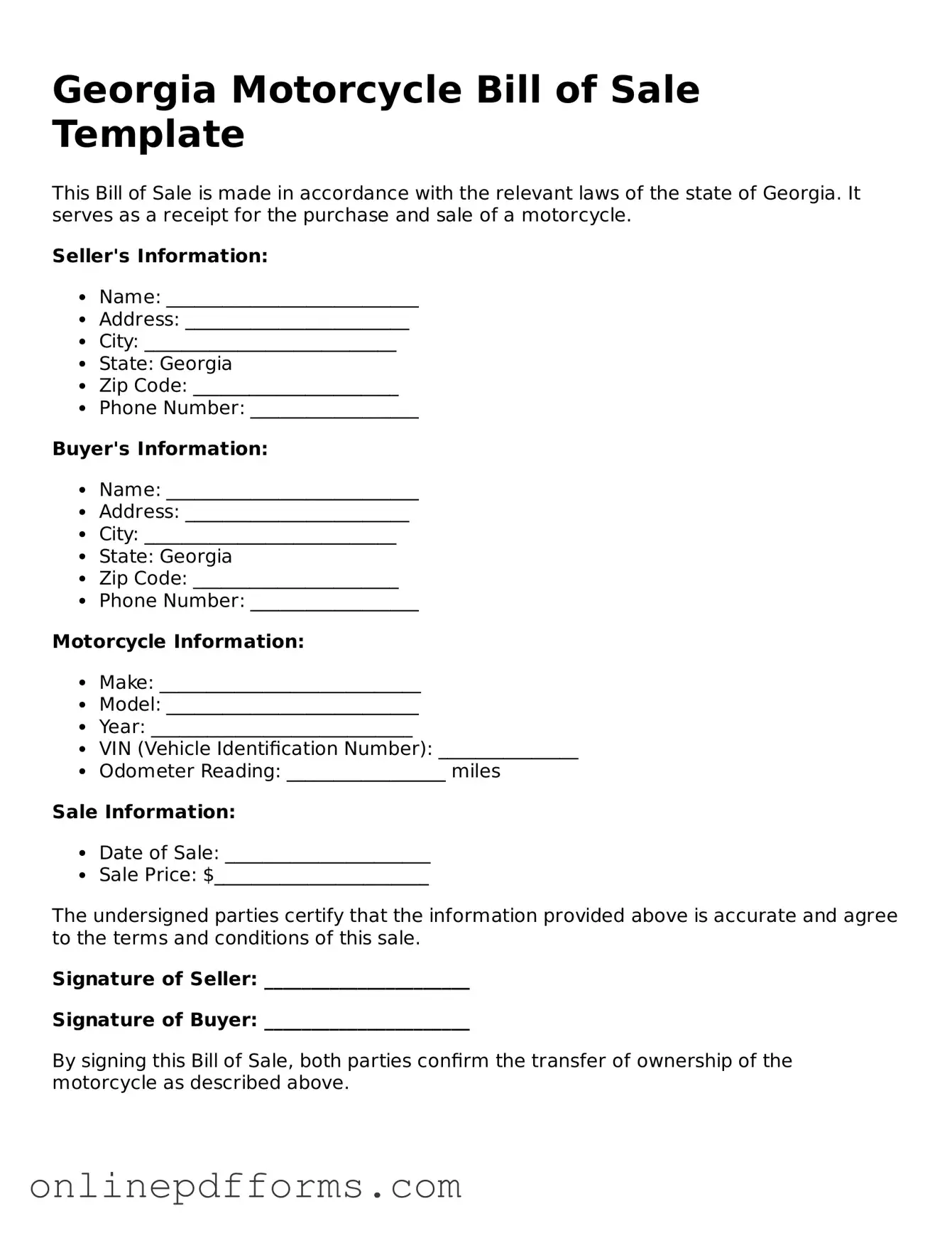The Georgia Motorcycle Bill of Sale form shares similarities with the Vehicle Bill of Sale. Both documents serve as legal proof of the transfer of ownership for a motor vehicle. They include essential details such as the buyer’s and seller’s names, addresses, and the vehicle identification number (VIN). Each form must be completed accurately to ensure that the transaction is recognized by the state. This is crucial for both parties, as it protects their rights and establishes a clear record of ownership.
Another document akin to the Motorcycle Bill of Sale is the Boat Bill of Sale. Like the motorcycle variant, this form is used to document the sale of a watercraft. It includes similar information, such as the names and addresses of the parties involved, the boat's registration number, and its hull identification number (HIN). Both forms facilitate the transfer of ownership and are often required for registration purposes, ensuring that the new owner can legally operate the vessel.
The ATV Bill of Sale is also comparable to the Motorcycle Bill of Sale. This document is specifically designed for the sale of all-terrain vehicles. It contains vital details, including the seller's and buyer's information, the ATV's make, model, and VIN. Just as with motorcycles and boats, this bill of sale serves as a legal record that protects the interests of both parties involved in the transaction.
Similarly, the Trailer Bill of Sale serves a purpose akin to that of the Motorcycle Bill of Sale. This document is used when a trailer is sold, detailing the seller's and buyer's information, along with the trailer's identification number. Both documents ensure that ownership is transferred legally and provide the necessary information for future registration and titling, which is essential for compliance with state regulations.
The Car Bill of Sale is another document that shares common ground with the Motorcycle Bill of Sale. This form is utilized for the sale of automobiles and includes similar components, such as the vehicle’s make, model, year, and VIN. Both documents are crucial for establishing a legal record of the transaction, offering protection to both the buyer and seller in the event of disputes or issues arising after the sale.
In a similar vein, the Mobile Home Bill of Sale serves to document the sale of a mobile home. This form contains information about the buyer and seller, as well as details about the mobile home, such as its identification number. Both the Mobile Home Bill of Sale and the Motorcycle Bill of Sale provide a clear record of ownership transfer, which is essential for legal and financial purposes.
The RV Bill of Sale parallels the Motorcycle Bill of Sale in its function of documenting the sale of a recreational vehicle. This document includes necessary details such as the buyer’s and seller’s names, addresses, and the RV’s VIN. Just like the motorcycle bill, it serves as a legal record that safeguards the interests of both parties, ensuring that ownership is transferred correctly and that the new owner can register the vehicle without complications.
The Snowmobile Bill of Sale is another document that resembles the Motorcycle Bill of Sale. This form is used for the sale of snowmobiles and includes similar information, such as the names and addresses of the parties, along with the snowmobile's identification number. Both documents are essential for providing a clear record of ownership transfer, which is necessary for legal compliance and future registration.
Additionally, the Farm Equipment Bill of Sale shares characteristics with the Motorcycle Bill of Sale. This document is used to record the sale of agricultural machinery and includes vital details such as the buyer's and seller's information, along with a description of the equipment being sold. Both forms serve as legal proof of ownership transfer, ensuring that both parties are protected in the transaction.
Lastly, the Lease Agreement can also be considered similar in some respects to the Motorcycle Bill of Sale. While it does not document a sale, it outlines the terms under which a vehicle may be used. Both documents require clear identification of the parties involved and the item in question. They establish the rights and responsibilities of each party, thus ensuring a mutual understanding of the transaction, whether it be a sale or a lease.
